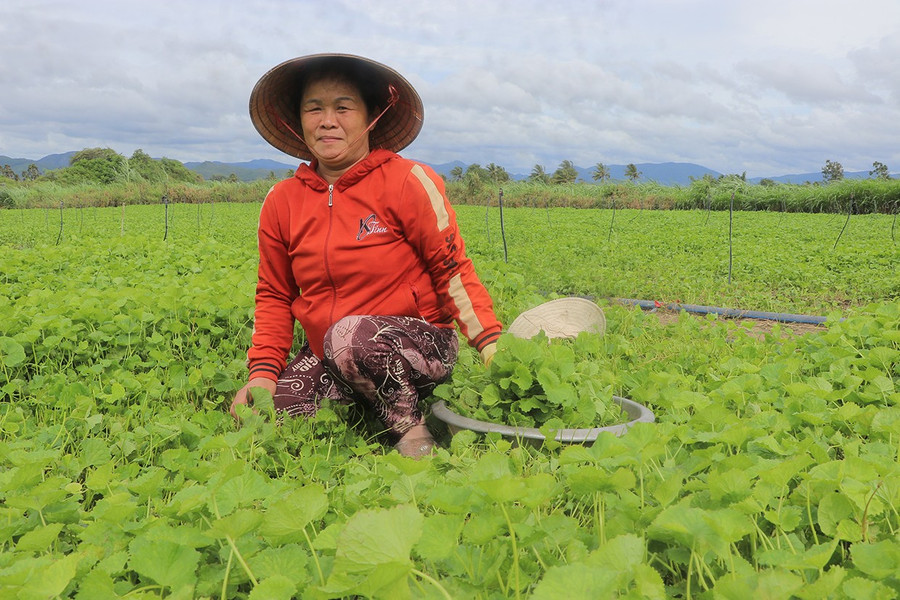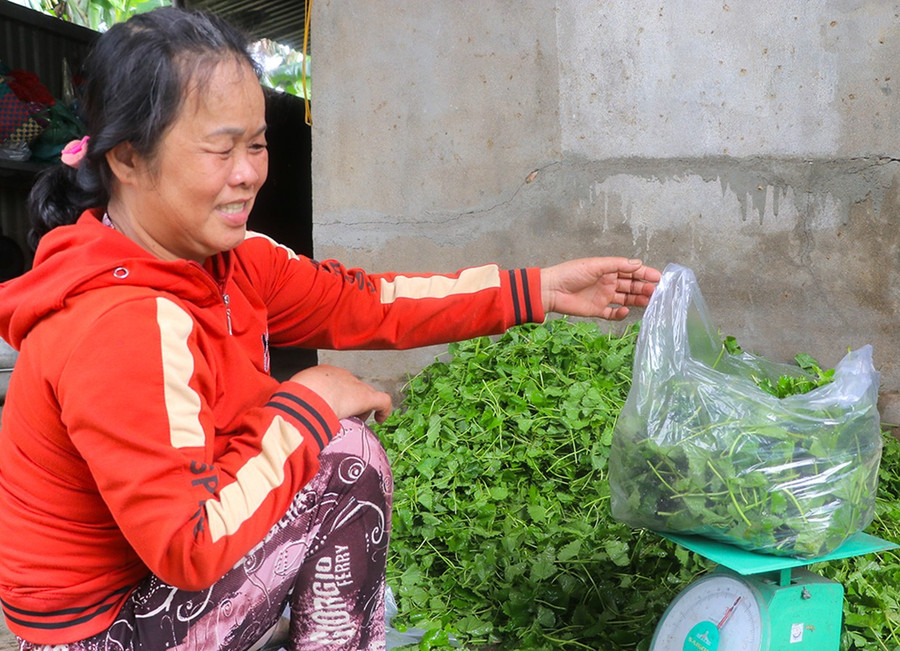
Ms. Nguyen Thi Anh's family owns over 6,000 square meters of land dedicated to growing various vegetables such as cabbage, jute mallow, water spinach, and cauliflower. At times, Ms. Anh switched to growing cucumbers, bitter melon, green beans, or herbs. While harvesting vegetables, she would often come across young, green purslane growing along the edges of the fields or in the vegetable beds. She would pick them and prepare them into various dishes or make juice. Often, she had excess purslane to sell, earning extra income. This gave Ms. Anh the idea to grow purslane to supply the market.
Ms. Anh said: Initially, she set aside a plot of land to try planting a few clumps of centella. After nearly a month, the centella grew, its shoots spreading across the ground. From there, she thinned out the young, densely growing plants and transplanted them to a new plot of land. But this method of propagation was very time-consuming, so she asked a relative to buy her 2 kg of centella seeds to sow like other vegetables, waiting for the plants to mature before transplanting them.
While waiting for the seedlings, Ms. Anh improved the garden soil, added organic fertilizer, and installed an automatic sprinkler irrigation system. “To reduce the burden of initial investment costs and have a regular income, I gradually expanded my water spinach cultivation model. From 2016 to 2018, water spinach covered more than 6,000 square meters, providing regular harvests,” Ms. Anh recounted.
According to Ms. Anh, pennywort is easy to grow and care for. If cared for according to proper techniques, it can be harvested in just 26-28 days. Pennywort prefers sunlight and moisture, so during the dry season, water it twice a day, in the early morning and late evening. During the rainy season, create deep trenches around the garden to drain water quickly and prevent flooding.
“To keep my vegetable garden lush and green, every year I fertilize it with over 1 ton of well-rotted cow manure and mix it with bio-fertilizer once a month. I researched and experimented with soaking ginger, garlic, and chili peppers in alcohol to make a pesticide to prevent pests and diseases in my water spinach garden. In addition, I grow my vegetables organically, so I am trusted and highly appreciated by the local people,” Ms. Anh shared.
To bring fresh, delicious vegetables to market, early in the morning or late in the afternoon, Mrs. Anh and her husband, along with their workers, harvest the vegetables, then carefully remove the old leaves and package them for supply to markets in Dak Po district and An Khe town. “Every day, I harvest and sell 35-40 kg of water spinach, at a price of 15-17 thousand dong/kg, earning nearly 200 million dong per year. Compared to some other leafy vegetables in the area, water spinach is easier to sell and provides a more stable income,” said Mrs. Anh.
According to Ms. Anh, weeding is the most time-consuming and labor-intensive task. Since the household is small and she and her husband are elderly, they have to hire one regular worker for weeding and harvesting vegetables at a daily wage of 150,000 VND. During peak periods, she hires an additional 2-3 people specializing in harvesting and packaging vegetables at a rate of 20-25,000 VND per hour.

Having worked for Mrs. Anh's family for many years, Ms. Ly Thi Nhanh (Tan Tu village) understands the process of caring for, weeding, and fertilizing the water spinach garden. Ms. Nhanh said: The high humidity in the water spinach garden creates favorable conditions for plant growth and development; this is also an ideal condition for weeds to thrive. Therefore, each day, she harvests the vegetables for about 1-2 hours, and the rest of the time is spent weeding, thinning, and replanting in empty spaces to ensure the garden is always densely planted.
"The work is easy but requires diligence and meticulousness. Although the income isn't high, it's stable. My house is close to the workplace, so I can take care of household chores and pick up and drop off my children at school," Ms. Nhanh confided.
Speaking with reporters, Ms. Pham Thi Ngoc Loan, Vice Chairman of the Tan An Commune People's Committee, said: "Tan An is a major vegetable growing area in Dak Po district. For many years, people have applied scientific advancements to production. Some households have boldly introduced new vegetable varieties to increase their income."
Ms. Nguyen Thi Anh's family was the first household in the commune to develop the model of growing Centella asiatica (Gotu Kola). This initiative has transformed wild-growing Centella asiatica into a marketable product; adding to the local list of leafy vegetables and providing a stable income for the family.
Source: https://baogialai.com.vn/trong-rau-ma-mang-lai-thu-nhap-on-dinh-post328491.html


![[Photo] Prime Minister Pham Minh Chinh presides over a meeting on private sector economic development.](/_next/image?url=https%3A%2F%2Fvphoto.vietnam.vn%2Fthumb%2F1200x675%2Fvietnam%2Fresource%2FIMAGE%2F2025%2F12%2F20%2F1766237501876_thiet-ke-chua-co-ten-40-png.webp&w=3840&q=75)



![[Photo] Prime Minister Pham Minh Chinh presides over the conference announcing the establishment of the International Finance Centre in Vietnam.](/_next/image?url=https%3A%2F%2Fvphoto.vietnam.vn%2Fthumb%2F1200x675%2Fvietnam%2Fresource%2FIMAGE%2F2025%2F12%2F21%2F1766309817714_ndo_br_dsc-3400-jpg.webp&w=3840&q=75)






































































































Comment (0)